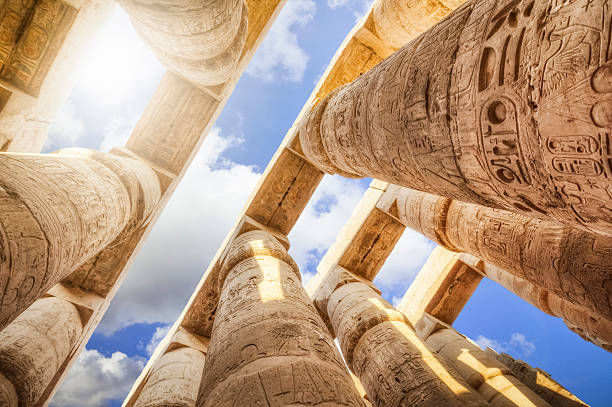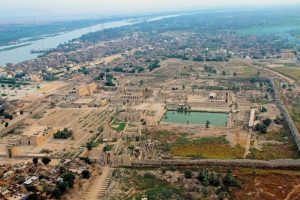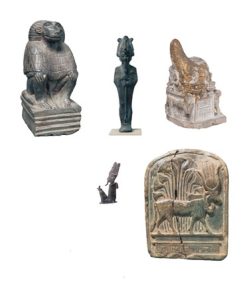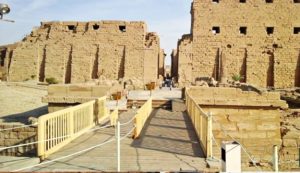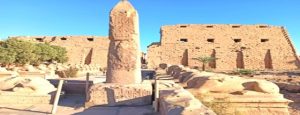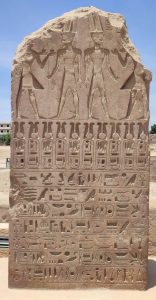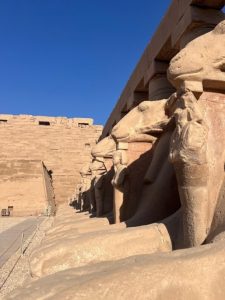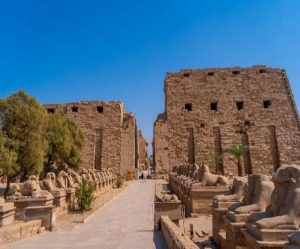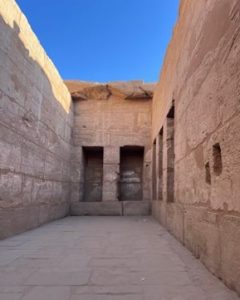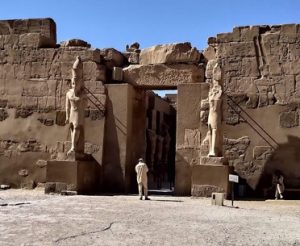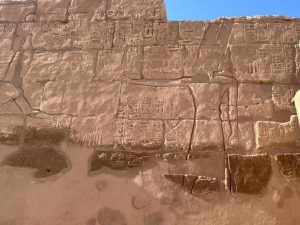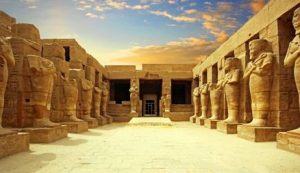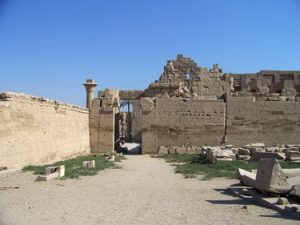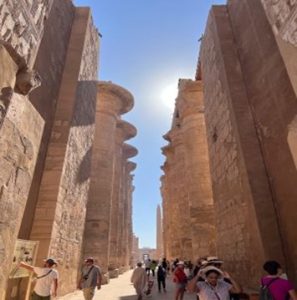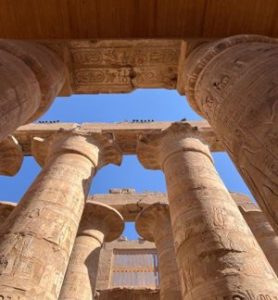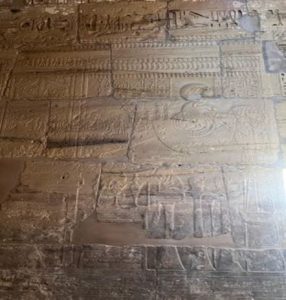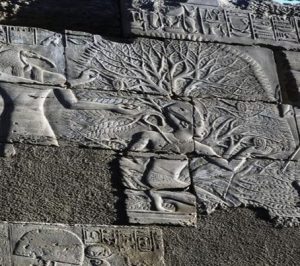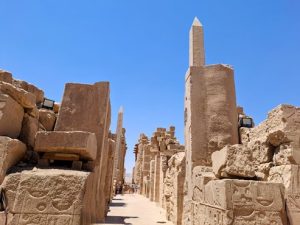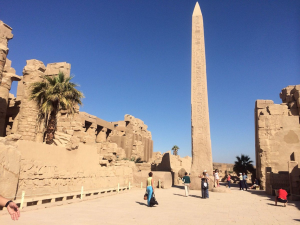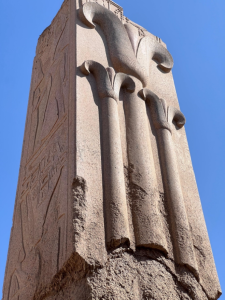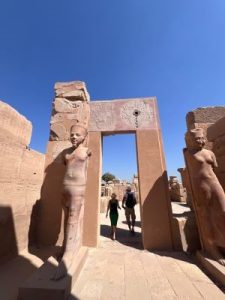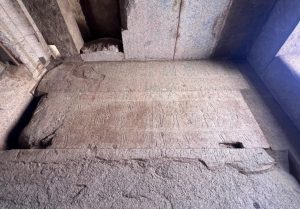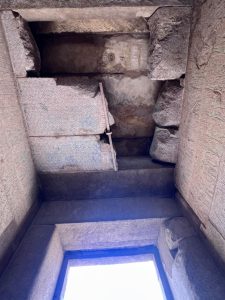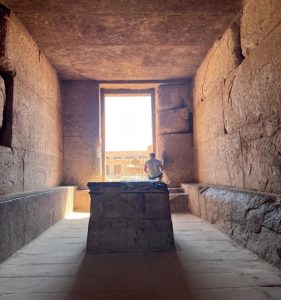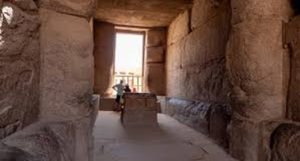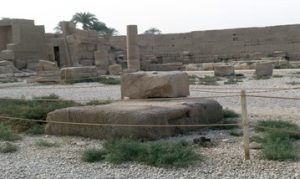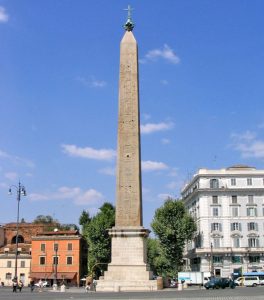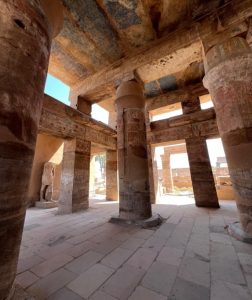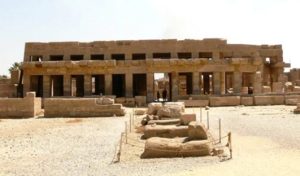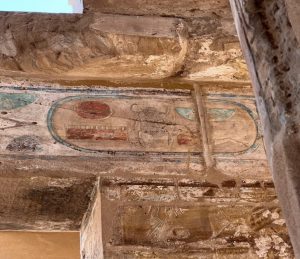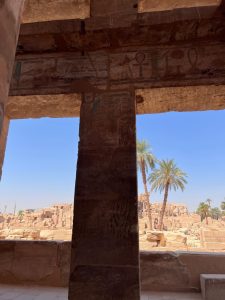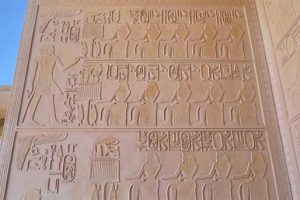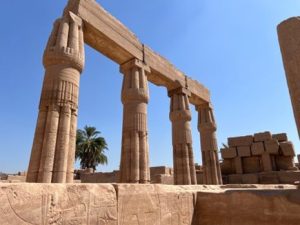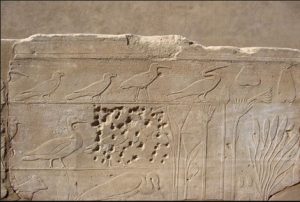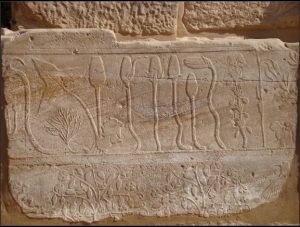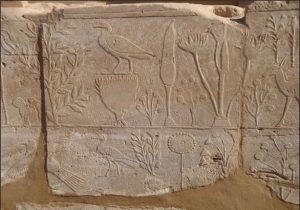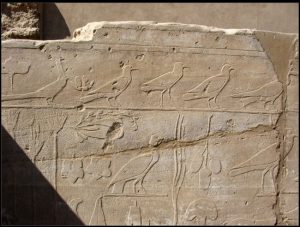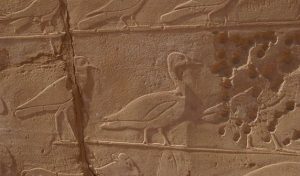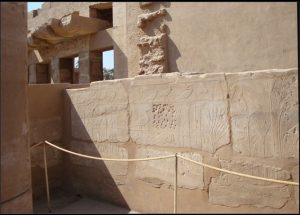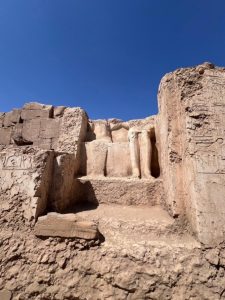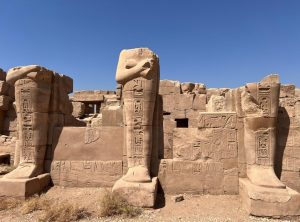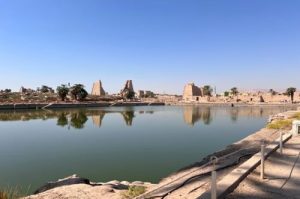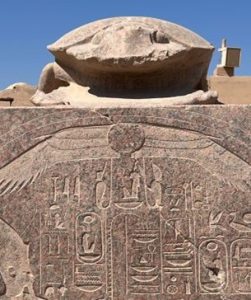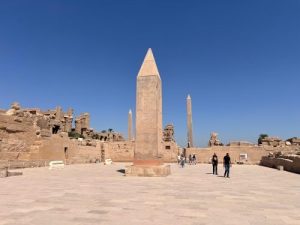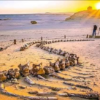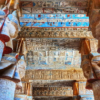Karnak Temple Complex
There is nothing in the ancient world greater than the Karnak temples, which were built on approximately 250,000 square meters. It is considered a huge architectural museum that includes many styles of architecture and arts. There is the great temple of Amun-Ra, as well as other temples such as the temple of his son Khonsu, located in the south, and in the north, the temple of Ptah, and in the east, the temple of Aton. Inside the temple of Amun-Ra, there is a temple for Ramses III. Also, in the northern courtyard, there is a hypostyle hall of Hatshepsut made of granite and a temple of Senusret I, in addition to the dwellings of the priests.
Naming
The ancient Egyptians called the temple “Ipet-sut,” meaning the sacred land, then it was called “Per-Amun,” meaning the house of the god Amun. As for the name Karnak, it is an Arabic name meaning the fortified village, due to the huge temples in Karnak.
History of the Construction of Karnak Temples
Upon his victorious return from his war against the Hyksos, Ahmose I decided to build a shrine for the god Amun in that spot, then he was followed by Amenhotep I, who was the first to plan to build the temple in the form we see it now. They were preceded by King Senusret I from the Middle Kingdom, who built a beautiful shrine called the White Chapel, which is now located in the outer northern courtyard of the Karnak Temple. Construction continued in Karnak for more than a thousand years, from the era of the New Kingdom until the Roman era in Egypt.
Aerial View of Karnak Temples
The Karnak Triad
Karnak was dedicated to the god Amun-Ra, his wife Mut, and their son Khonsu. Amun-Ra, the god of Thebes, his name means the hidden, and he is depicted as a man with two feathers of justice on his head and a sun disk between them, and his animal form is a ram, which is a symbol of fertility for the ancient Egyptians. His wife Mut means her name is the mother, and her main temple is the temple of Luxor, which was known as the house of marriage between them. The son Khonsu is the moon god. The ancient Egyptian believed that the Nile was the husband and the Egyptian land was the wife, and since he believed that the gods marry like humans, he therefore celebrated the marriage of the god Amun-Ra to his wife Mut in a festival called the Opet festival, where the statue of the god Amun would go in a large procession of boats through the Nile to the temple of his wife (the temple of Luxor ), going through the Nile, and therefore the whole city celebrates this great festival. Then the boats enter the house of marriage and the people there celebrate by offering sacrifices from the rich and feeding the poor, and the celebrations continue inside the temple. At the end of the celebrations, they return carrying the offerings in the Avenue of the Sphinxes between the temples of Karnak and Luxor for some of the people to see the great celebrations. And one of the most interesting things we found in the Avenue of the Sphinxes were places where people used to celebrate and sit to eat and drink.
The Triad of Thebes Amun is depicted in the center, with his wife Mut on his left and their son Khonsu on his right.
The Wealth of Amun-Ra
Amun-Ra is considered the wealthiest of the Egyptian gods because the Egyptian empire in the New Kingdom encompassed most of the ancient world. Therefore, its wealth reached unprecedented levels for any empire in the world until now. For example, Amun had more than 50 ships, all with gold-plated prows, and more than 200 statues made of pure gold. It was dedicated entire villages surrounding his temples to him, amounting to over a million hectares of land. As a result, he employed more than 80,000 workers in his temples, engaged in agriculture, livestock breeding, and temple service.
The statue of the god Amun Ra is plated with gold
The Karnak Cache
Between 1903 and 1911, the Frenchman Legran began excavating at the Karnak Temple and discovered a cache in the hypostyle hall known as the Karnak Cache. The cache contained 20,000 objects, 17,000 small statues, and about 700 painted reliefs. The cache was discovered at a depth of 10 meters of mud. Most of these artifacts were transferred to the Egyptian Museum in Tahrir.
A picture of the discovery of the Karnak cache
Some pieces of the Karnak cache discovered by Georges Legran
Description of the Most Important Parts of the Temple The Great Temple of Amun-Ra
The Quay: The ancient Egyptians used to connect their temples to the Nile River. As mentioned, there was a divine marriage procession (the Opet festival) where the procession of the god Amun would sail from the Karnak Temple to the Luxor Temple where his wife, the goddess Mut, would await him. This quay was specifically built for the procession of the god Amun. The priests would carry the boats of the god Amun on their shoulders from the temple until they reached the quay, where they would place them on it. There was a canal between the quay and the Nile River. Therefore, the quay was used as a Nile meter. In the middle of the quay, there was a square base for the sacred boat, and there were two obelisks of red sandstone that adorned the quay. They were erected by King Seti II of the 20th Dynasty. Only one remains, with a height of about 2 meters and a base of about 75 cm. The other obelisk only has its base remaining.
A picture of The Quay
A picture showing one of the two obelisks made of red quartzite stone, two meters long, at the entrance to the Karnak Temple. They belong to King Seti II.
A granite palette of King Seti II, with all his royal titles on it. It is to the left of the main entrance to the Karnak temples. It has a sculpture of god Amun Ra.
The Avenue of the Sphinxes (Rams Road )
It is 52 meters long and 13 meters wide. It is a path lined with two rows of sphinxes (ram head and lion body), the ram is the animal symbol of the god Amun-Ra, symbolizing fertility and vitality, while the body of the statue is in the form of a lion, representing strength and protection. This avenue was built in the era of King Ramses II, who placed a small statue of himself under the sphinxes to be protected by the god Amun-Ra. This avenue extended to the second pylon before the construction of the temple’s facade. Therefore, we find a group of statues between the quay and the first pylon, numbering 20 statues on each side. After the gate and in the first pylon, we find 33 statues on the southern side and 19 on the northern side. There were basins for planting trees between the statues and the temple, irrigated with pottery vessels that carried water from a well dug behind the southeastern end of the sphinxes.
Rams Road from the western Quay to the first pylon
Pictures of tree planting beds i

n front of the temple
A picture showing statues of rams with statues of the king in their hands
The First Pylon
It is considered the largest pylon in all of Egypt, with a length of 113 meters, a height of 45 meters, and a thickness of 15 meters. It dates back to the reign of Nectanebo I of the 30th Dynasty. The pylon was adorned with four standards, one on each wing of the pylon. A staircase on the northern wing led to the top of the pylon, and there were mud ramps on the eastern side of the southern wing that were used to transport stones for construction.
The first pylon of the temple shows that the northern tower is incompletely built
A picture showing the clay slopes on the eastern side of the southern wing of the edifice, which were used to transport stones over them for construction
The First Courtyard (Hall of Festivals)
This is the only place where all the people were allowed to enter. It follows the first pylon and has an area of 80 meters by 100 meters. It is the largest courtyard in Egyptian architecture. It was built in the era of the 22nd Dynasty during the reign of Shoshenq I. On either side of the courtyard, a single row of massive papyrus columns with bud capitals was erected.
A picture from inside the first courtyard shows the columns with papyrus capitals and in front of them the rest of the rams’ road inside the temple
The Chapels of Seti II
Located on the north side of the entrance to the first pylon, they are a small building made of limestone consisting of three chapels built as a resting place for the sacred boats. The central chamber was for the sacred boat of Amun-Ra. The western chamber, on the left side of the entrance, was for the goddess Mut’s boat. The eastern chamber, on the right side of the entrance, was for Khonsu’s boat. Seti II called these chapels “the great temple for millions of years” The most important scenes on the shrines are: the king offering maat as an offering alongside fats and flowers to the sacred boats of Amun, Mut, and Khonsu. Scenes depict King Seti II in his religious relationships with various deities. The shrines are distinguished by the presence of niches that were specifically designated for the statues of the triad of gods, along with one dedicated to Seti II himself.
A picture showing the palaces of King Seti II
A picture inside the palaces of King Seti II shows the niches in which the statues are placed
The Pylon of Taharqa
It was built by King Taharqa, one of the kings of the 25th Dynasty, in the middle of the open courtyard (and perhaps he moved the Avenue of the Sphinxes from the middle of the temple to the sides to build a pylon for himself). The building consists of 12 columns in the shape of a papyrus flower, connected by a short wall called a screen wall built in the Ptolemaic era. All the columns collapsed, except for one, which is the second tallest column in Egypt after the column of the obelisks. Kings Psamtik II and Ptolemy IV inscribed their names on these columns. In the middle of the first courtyard, there are two stone bases. It is believed that one of them was the royal table for visitors to the temple. During the celebrations, offerings were made on it by the king and the great men of the state to the Karnak Temple. The priests would cook this food and offer it daily in this courtyard to all visitors to the temple, and the poor would take food from it for their wives and children at home. The other base was for placing the boat of the god Amun during the celebrations for the people to see
Taharqa Columns: One column is intact and the stone base is visible in front of it
Temple of Ramses III
Located south of the first courtyard on the right side of the entrance, it is considered a divine temple dedicated to the resting of the sacred boats of the Theban Triad in the era of Ramses III. The temple, measuring 52 meters in length, consists of the following: A pylon A ramp precedes it, with two sandstone statues of the king. An open courtyard With two rows of columns, 16 columns, eight on each side, and in front of each column, a statue of the king in the Osirian form. A hypostyle hall Its ceiling is supported by 4 papyrus columns with bud capitals. A hypostyle hall Its ceiling is supported by eight columns in two rows with capitals in the shape of papyrus buds. Holy of holies And it consists of three shrines: the middle one for the boat of Amun, the right one for Khonsu, and the left one for Mut. Scenes of the temple Of Ramses III on the pylon, there are images of the king with a priest, slaughtering his captives before Amun, who presents him with three rows of the lands that the king had seized. This scene has been depicted in a unique way, with each city represented by a person emerging from a cartouche containing the name of the city that was conquered. On the rear wall of the pylon, a depiction of the king in his various relationships with Amun, who gives the king the sign of the sed festival. A scene depicting the procession of the sacred triad, with the king leading the priests who carry the sacred procession of the triad. A scene depicting the procession of the god Min, the god of fertility, with the king offering incense to the statue of Min-Amun. The king in his various relationships with different gods. Scenes of purification, offering incense, making offerings, and performing other religious rituals.
A picture showing the entrance to the temple of King Ramesses III, with two sandstone statues of the king and inscriptions on the pylon on the right and left, most of which are missing.
A picture showing the inscriptions on the walls of the Temple of Ramesses III behind the two statues at the entrance
A picture showing the open courtyard with two rows of columns, about 16 columns. In front of these columns are statues of King Ramesses III in the image of Osiris
The Bubastite Gate
Located to the east of the temple of Ramses III and directly before the second pylon, the gate was named after the kings of Bubastis. Scenes of sacrifices to the Theban triad are inscribed on the gate. There is a double scene of Takelot II and his son Osorkon, the high priest of Amun Ra, where Osorkon presents a maat to Amun Ra on the left side to Amun Ra, and on the right side the offering is made by Takelot II. In another double scene, Osorkon, the high priest of Amun, presents bread on the left side to Amun-Ra, the revered one of Karnak, and on the right side, he presents bread to Amun-Ra Hor-Akhty, alongside a text of King Shoshenq’s victory and the suppression of enemies.
The Bubastite Gate in Karnak
The statues of Ramses II In front of the second pylon
The second pylon is preceded by two statues of King Ramses II. The most famous statue on the left side, which depicts the king in the Osirian form holding the royal insignia (the crook and flail), and at his feet is a small statue of his daughter Bent-Anat, who was named after the Syrian goddess Anat, and perhaps this name was given after the peace treaty he signed following the battle of Kadesh (this statue was inscribed with the name of the priest Panjem from the 21st dynasty, and therefore is sometimes known as the statue of Panjem). While the statue On the right is in a natural position, with the left leg forward as if in a state of motion.
The statue of Ramesses II in front of the second pylon (the priest Panjem from the 21st Dynasty, wrote his name on it, which is why it is sometimes known as the statue of Panjem)
The Second Pylon
Built by Hor-moheb and completed by Ramses I, both Ramses II and Ptolemy VIII added their names to the pylon. The pylon was damaged when the French engineer Legran attempted to clean the temple in 1885 and opened the floodgates, causing the floodwaters to destroy many buildings in Karnak, most importantly the second pylon and part of the columns of the great hypostyle hall. However, this destruction had a positive aspect as it revealed the “talatat stones”, which Akhenaten had used to build his temple in Karnak. Following the end of his heretical movement regarding the ancient Egyptian faith, Hor-mheb dismantled his buildings and used them as fillings to build the second pylon.
The Great Hypostyle Hall
The most important part of the Karnak Temple is the Great Hypostyle Hall. Champollion said that if we dismantled the stones of the hypostyle hall, we could build a wall around all of Paris one meter high, which indicates its immense size. Many international and Egyptian films were shot in this hall, most notably a part of the film “Murder on the Orient Express,” based on the story of the famous English writer Agatha Christie. The famous Egyptian actor Omar Sharif also filmed his first Egyptian film here, titled “Struggle in the Valley.” It consists of 134 sandstone columns arranged in 16 rows. The two main rows (12 columns) have capitals in the shape of an open papyrus flower, built by King Amenhotep III. The other columns (122 columns in 14 rows), with 7 rows on each side, are in the shape of a closed papyrus flower, and were built by King Seti I and completed by his son Ramses II. This part was the first to be built in the hypostyle hall. The lighting in the great hypostyle hall is through the windows located above the third and fourth rows (the beginning of the rows of closed papyrus columns). Why? Because, as mentioned, the open courtyard is accessible to the general public, while the hypostyle hall is a place that only priests enter, carrying the sacred boat of the gods and taking it out to place it in the open courtyard. Therefore, the lighting and ventilation here are through the windows from above, as they only illuminate the path that the procession of the god takes in the middle of the hall between the 12 columns. The most important inscriptions on the walls of the hall in the northern half belong to King Seti I, and the southern half to Ramses II. Other kings, such as Ramses III and VI, also added their names to the columns of the hall.
The most important scenes in the hypostyle hall:
The north wall: Seti I kneeling under the sacred tree and the god Thoth writing his name on its leaves. This is considered the most beautiful scene in the history of Egyptian sculpture. We find King Seti I sitting inside the tree and the god Thoth writing his name on the leaves of the tree, which means that the king is receiving a new year of his reign and will rule for many years. Scenes of Seti I’s battles with the Asian. A scene of King Seti I offering flowers to the god Ra-Hor Akhty. A scene of the boats of the god Amun, with their prows in the shape of a ram (these boats are not the ones that enter the water but are placed on another boat that is placed in the water). The south wall: Scenes of Ramses II’s wars in Syria. We see scenes of King Ramses II in his wars against the Syrians and Asians, most notably the Battle of Kadesh. We see King Ramses II inside his war chariot shooting arrows at the enemies, then we see three rows of prisoners tied with a rope. We see in one scene the enemies falling down in front of the king in fear of him. We see another scene of the king and his soldiers storming a foreign fortress. Then scenes of the king returning victorious and being greeted by musicians with music in celebration of the victory. Then a scene of King Ramses offering the prisoners to the god Amun in celebration of the great victory. The inscription of the poetic text of the Battle of Kadesh, the Poem of Pentaur. Ramses II recorded his name on the northern and southern entrances with his attributes.
Pictures of the middle aisle in the Hypostyle Hall
The windows that illuminate the path of the god’s procession in the Hypostyle Hall
A view of the boat of the god Amun-Ra from the hypostyle hall, its front and back in the shape of a ram
The most beautiful scene in the inscriptions of Egyptian civilization is the scene of the god Thoth, the god of wisdom, writing on the Tree of Eternity the name of King Seti I, who sits inside the tree and all the leaves have his name on them. This indica
Obelisks of Karnak Temple
Obelisks of Karnak Temple Between the Great Hypostyle Hall and the obelisks were the buildings of the third pylon, which was erected by Amenhotep III, but it is now completely destroyed. The obelisks are located in the fourth and fifth pylons. Obelisks were always a symbol of the sun god Ra, due to their pyramidal top, which was always painted with gold and bronze plates. When the sun shone on them, they would shine during the day, and when the sun set, they would shine at night. Therefore, they were always the highest parts of the temple, and thus they were always an announcement of the presence of the temples.
Obelisk of Thutmose I:
King Thutmose I erected the fourth pylon, and only one obelisk of Thutmose I remains, with a height of 19 and a half meters and a weight of 143 tons. It has three rows of middle hieroglyphs of Thutmose I, and the remaining two rows belong to Ramses IV. On the base, there are scenes of Ramses II. There were also two obelisks of Thutmose III in front of this pylon, one of which is now in Istanbul in front of the Sultan Ahmed Mosque, and the other in New York.
Obelisk of Hatshepsut:
King Thutmose I also erected the fifth pylon, in which his daughter, Queen Hatshepsut, built two obelisks of pink granite. One of them is still standing with a height of 29 and a half meters and a weight of 323 tons, and the base has a height of 2 meters and 65 cm. It is inscribed with the story of the erection of the obelisks, the reason for their erection, and the time of their cutting. The second obelisk fell in an earthquake, and only its top remained, which was erected in 2023 AD next to the commemorative scarab and the sacred lake. Interestingly, when King Thutmose III ruled, he wanted to hide the obelisks, so he built a wall around them, but over time the wall collapsed and the obelisks remained, preserving them without his knowledge, because the top of the obelisks was coated with a layer of electrum, a mixture of gold and bronze.
Obelisks of Karnak Temple
The Obelisk of Tuthmosis I in the Karnak Temple is about 19 and a half meters high
The Obelisk of Queen Hatshepsut, made of pink granite, is 29 and a half meters high
The First Hall of Annals
Thutmose I erected it as part of the sixth pylon. In front of it are two pink granite columns, one in the shape of papyrus and the other in the shape of a lotus. There are also two statues of Tutankhamun.
Picture of the pink granite column of Tuthmosis III with a lotus flower on it
A pink granite column shaped like a papyrus leaf
Two statues of Tutankhamun
The Holy of holies
Thutmose III erected the second hall of annals and in the middle of it, he erected the Holy of holies (the one that currently exists was erected by King Philip Arrhidaeus, the half-brother of Alexander the Great). It is a chamber made of pink granite with a base in the middle on which the sacred boat of Amun is placed.
The most important scenes in the Holy of Holies:
On the right wall, there are scenes of the king’s coronation and his presentation to the god. And scenes of the sacred procession of the god Amun. And we see wonderful scenes of the ceiling adorned with the sky. We also see scenes of offering sacrifices on the walls of the Holy of Holies. It is also noted that Parts of the ceiling are ruined.
Entrance of Holy of Holies
Inscriptions on the façade of the Holy of Holies depict him offering sacrifices to Amun
Scenes of offering sacrifices to the god Amun Ra from inside the Holy of Holies
The roof of the Holy of Holies showing the missing parts of it
The table of the sacred boat of Lamon inside the Holy of Holies
The Holy of Holies, at the end of which there is a window overlooking the courtyard of the Middle Kingdom and the temple of Akh Menu
The Middle Kingdom courtyard
After the end of the Holy of holies, we find a large open courtyard from the Middle Kingdom era. It is believed to be the oldest place in the temple, but unfortunately, there are no remains in it. Behind it was an obelisk of Thutmose IV, which is the only obelisk in the history of Egyptian civilization that was found alone (because all obelisks are built in pairs, symbolizing the north and south). It has a height of 46 and a half meters and is the tallest obelisk ever. It is now located in Piazza del Laterano in Rome.
Middle Kingdom courtyard at Karnak
Obelisk of Tuthmosis IV in Rome
The Celebration Hall (the Akh Menu)
Built by King Thutmose III, the greatest king of Egypt, this hall was inspired by the shape of a tent used during wars. Thutmose III led 17 military campaigns and successfully expanded the borders of the Egyptian Empire to southern Turkey in the east and central Africa in the south.
Key features of the Akh Menu:
Hypostyle Hall: This hall consists of 22 columns where the engineer tried to imitate the shape of a royal tent during wars. The column here is like a peg driven from top to bottom, and the top of the column’s capital is like an inverted crown. Chambers: The southern and northern chambers were dedicated to storing the temple’s supplies. The most important chamber on the southwestern side is where the Karnak List (the Tablet of the Ancestors) was found in 1842. It is now in the Louvre Museum in Paris. It is a tablet written in the era of King Thutmose III, listing the names of all the kings who ruled before him. It is considered one of the sources of ancient Egyptian history.
An image of columns in the form of inverted capitals representing the shape of the tent in Akh Menu
Pictures showing the celebration hall (Akh Menu)
Pictures showing the celebration hall (Akh Menu)
Pictures showing the celebration hall (Akh Menu)
A copy of Karnak’s genealogy is currently in the Akh Meno, but the original copy is in the Louvre
The Eastern Chambers
In the middle is the Holy of holies, and to its north is a hall with four columns known as the “Botanical Garden.” The Botanical Garden in Karnak This was the first botanical and zoological garden in the world. King Thutmose III brought from his campaigns, especially in Syria and Asia, a group of animals and plants that were not found in Egypt, most notably the hoopoe, some types of geese, and some plants such as Pomegranate and eggplants. This indicates the king’s wisdom and his being ahead of his time, as he did in his military campaigns and political affairs. He is considered the emperor of the ancient era thousands of years before Alexander and Napoleon.
Picture of the four-columned hall
Pictures showing the botanical garden
Pictures showing the botanical garden
Chambers of the Priests
On the sacred lake, there are remains of the houses of the priests, which are now located under the seats that were built for the sound and light show. These ruins are located on the eastern side of the lake, and archaeologists have recently discovered a number of pottery pieces, symbols, seal impressions, and coins dating back to the reign of Shoshenq I of the 22nd Dynasty, in addition to pottery vessels from the 26th Dynasty. Silver ingots and a silver coin of North Greek origin dating back to the 27th Dynasty were also found.
An image showing the priests’ Chambers around the sacred Lake
A picture showing the Osirian statues around the sacred lake and the priests’ Chambers
A picture showing the Osirian statues around the sacred lake and the priests’ Chambers
Inscriptions on the Walls around the temple and the sacred lake
The Eastern Gate
King Thutmose III began building the eastern temple, and then King Ramses II added a gate to the temple on the eastern side, called the Gate of Amun, who listens to the prayers of the worshippers, because a statue was found indicating this. Therefore, people believe until today that all their requests are answered at that gate.
The Sacred Lake
The sacred lake was known in all Egyptian temples for its symbolism, as it represents the primordial water, Nun. Therefore, kings, priests, and even statues of gods were purified in it. It was always connected to the Nile River through underground channels. One of the miracles of the sacred lake in Karnak is that the water retains its properties and renews itself despite the passage of thousands of years. It was founded by Thutmose III and is 80 meters long and 40 meters wide.
The Sacred Lake
The Memorial Scarab of Amenhotep III
For the ancient Egyptians, the scarab was a symbol of the sun and renewal. The ancient Egyptian saw the scarab laying eggs, then hatching, and considered it like the sunrise. It was blessed as a symbol of the renewal of life, as if it were a return to youth again. Therefore, kings used its shape in royal seals, and people used it in amulets and necklaces. This scarab was located behind the statues of Memnon in the temple of Amenhotep III in the western bank and was moved to the Karnak Temple next to the sacred lake Even today, it is believed by Egyptians that circling around the scarab seven times fulfills wishes. If a woman is barren, she will become pregnant, and if she wants to give birth to a boy or a girl, she will. In this scene, we see King Amenhotep III worshipping the god Aton
Memorial Scarab in Karnak (Wish Granter)
The Memorial scarab in Karnak (waiting for you)
The Remains of Hatshepsut’s Obelisk
The southern obelisk of Queen Hatshepsut in the Karnak Temple fell, breaking it. Its head and upper part remained lying next to the sacred lake until 2023 AD, then it was assembled and erected next to the sacred lake, with a height of about 11 meters

